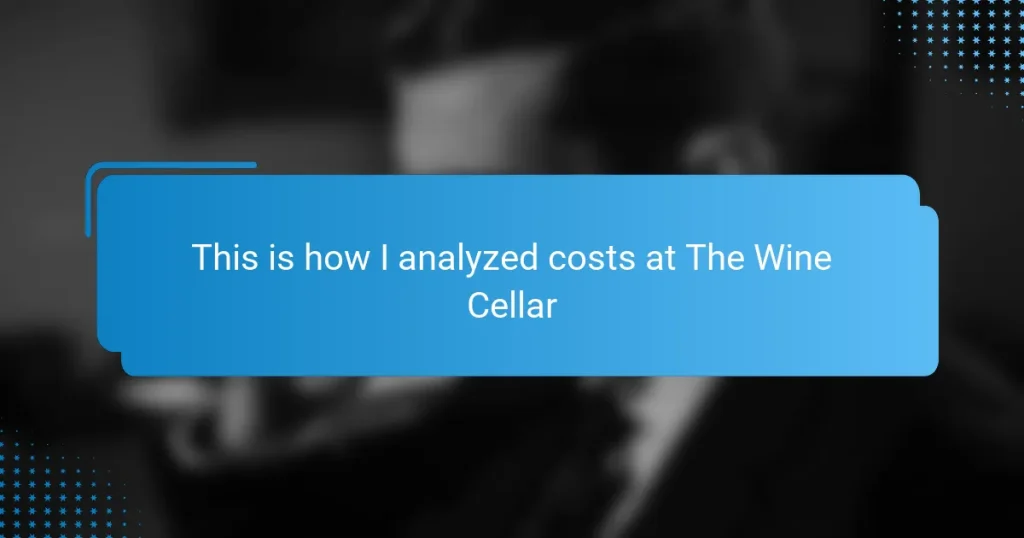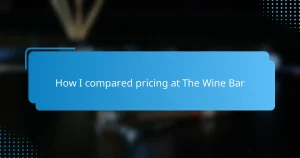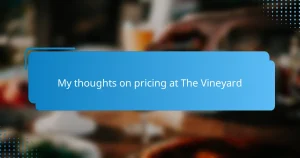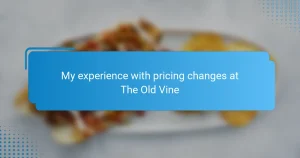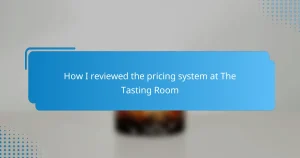Key takeaways
- Understanding wine bar costs involves not just the wine itself, but also the ambiance, service, and unique selections that enhance the overall experience.
- Common expenses include staffing and ambiance, which contribute to a memorable tasting moment beyond just the price of the wine.
- Analyzing prices through comparison and portion sizes helps reveal true value and can uncover hidden gems or overpriced options.
- Personal connections and storytelling enhance the appreciation of wine, making costs feel justified and adding emotional value to each glass.

Understanding Wine Bar Costs
When I first looked at the prices on The Wine Cellar’s menu, I wondered, what exactly am I paying for? It quickly became clear that understanding wine bar costs isn’t just about the price tag but about what goes into each pour—the quality of the wine, the ambiance, and the expertise behind the scenes. Have you ever stopped to think why a glass of wine can range from a modest sip to a hefty indulgence?
From my experience, wine bars like The Wine Cellar invest in sourcing unique bottles and maintaining a certain atmosphere, which inevitably affects cost. It’s not just about buying wine wholesale; it’s also about the knowledge and service that make your tasting moment memorable. Knowing this helped me appreciate that those dollar differences reflect more than just liquid in a glass.
I’ve found that sometimes the emotional value of sharing a thoughtfully selected wine with friends adds an intangible cost we rarely consider—something beyond numbers on a receipt. So next time you glance at the prices, ask yourself: am I paying for just wine, or for an experience? That question changed how I see wine bar pricing forever.
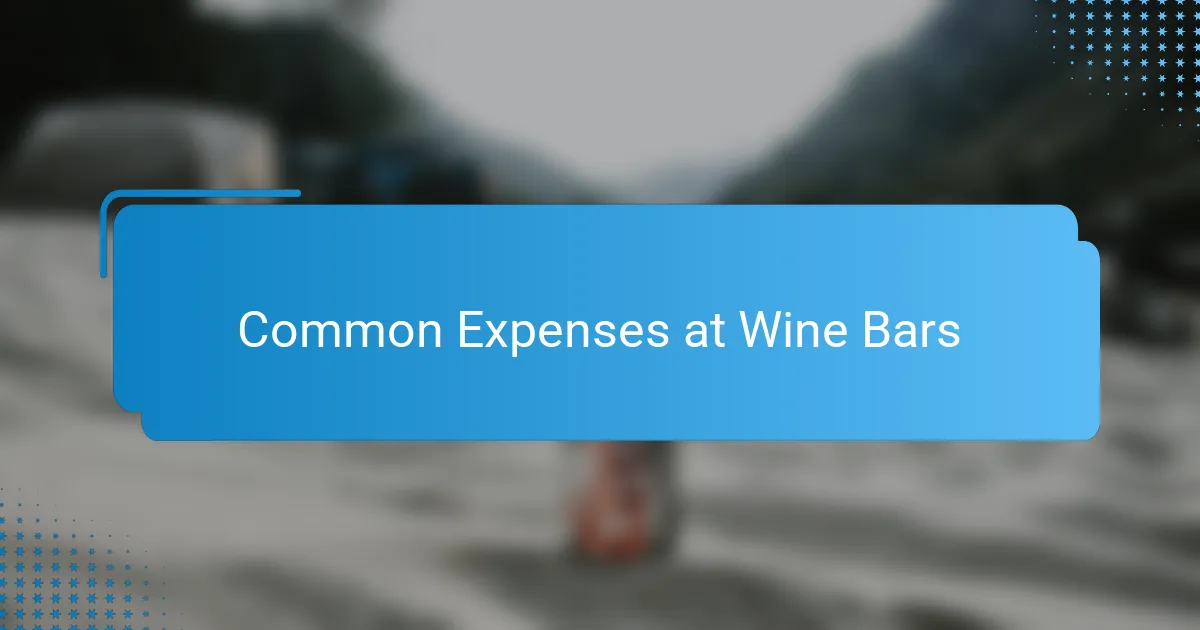
Common Expenses at Wine Bars
Expenses at wine bars often go beyond just the bottle or glass you order. I noticed that staffing costs—skilled sommeliers and attentive waitstaff—play a big role in how prices add up. Have you ever thought about the training and passion behind the person recommending your favorite vintage? That expertise doesn’t come cheaply, and it enriches your experience in ways that the menu can’t fully capture.
Another common expense I realized is the overhead involved in creating the right ambiance. Think about the cozy lighting, tasteful decor, and even the background music that sets the mood. These details aren’t accidental; they cost money and effort. When I sip a glass at The Wine Cellar, I’m also savoring an environment designed to make me feel relaxed and special—and that’s worth something.
Then there’s the cost of carefully curating the wine list itself. The Wine Cellar often stocks rare or limited-edition bottles, which naturally come with a higher price tag. I’ve often wondered, what’s behind the choice to offer that exclusive bottle? It’s the thrill of discovery and the story behind each label that, in my opinion, make those costs feel justified. It’s not just wine for sale—it’s a journey in a glass.

Methods for Analyzing Wine Bar Prices
When I analyzed The Wine Cellar’s prices, I started by comparing them with other local wine bars to gauge where they stood. Asking myself if a higher price meant better quality or just a premium for the setting helped me cut through the surface numbers. It’s like shopping for shoes—I want to know if I’m paying for comfort, style, or just the brand.
Next, I broke down the menu into categories—by glass, by bottle, by vintage—and noted patterns in pricing. This method helped me spot if certain wines were competitively priced or if some were marked up for exclusivity. From my experience, this granular look often reveals hidden gems or overpriced sips, much like uncovering a secret on a treasure map.
Finally, I paid attention to the portions and serving styles. Have you ever noticed that the same varietal can come in different glass sizes? By measuring pours and considering the tasting experience, I could better judge the true cost per sip. For me, understanding this made each glass feel more intentional, not just a number on a bill.

Tools Used for Cost Analysis
To dive into cost analysis at The Wine Cellar, I relied heavily on spreadsheet software to organize and compare prices, portions, and wine origins. Creating detailed tables helped me visualize where expenses clustered—was it the rare vintages or the everyday offerings that tipped the scales? This simple tool turned a jumble of numbers into a clear story.
I also used mobile apps that track wine prices across retailers and bars, giving me real-time data to benchmark The Wine Cellar’s costs. It felt like having a knowledgeable friend whispering market secrets as I sifted through the menu. These insights made me ask: am I getting a fair deal or paying for exclusivity?
Last but not least, I kept notes by hand throughout my visits, jotting impressions about service quality, ambiance, and pour sizes. Reflecting on these alongside the raw data added depth and emotion to my analysis. After all, numbers tell one side of the story—but the atmosphere and care infused into each glass make all the difference.
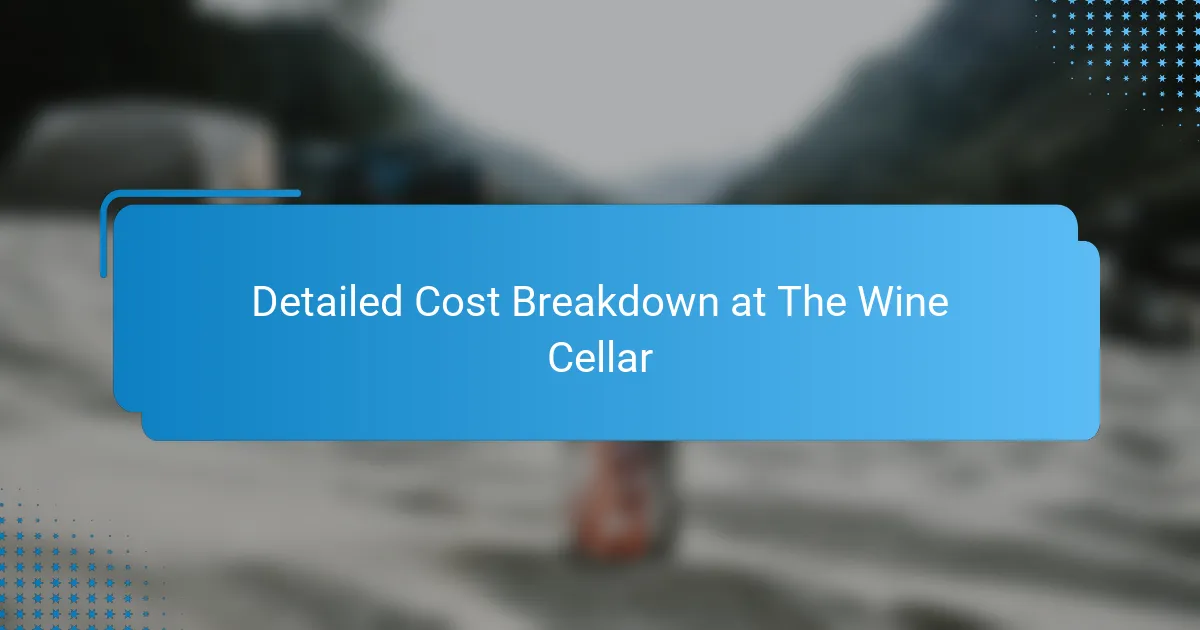
Detailed Cost Breakdown at The Wine Cellar
Diving into the detailed costs at The Wine Cellar, I first broke down the prices by category—by glass, bottle size, and vintage—to see where the value really lay. What struck me was how some wines carried a premium not just because of rarity, but due to how thoughtfully they were paired with the overall experience. Have you ever noticed how a slightly higher price can translate into a more memorable sip? That’s exactly what I found here.
I also paid close attention to the serving sizes and pour styles, realizing that not all glasses are created equal. Sometimes, a generous pour of a mid-range bottle felt like a better deal than a tiny taste from a pricier vintage. This made me appreciate how portioning affects perceived value, turning the glass into more than just a number on the menu—it shapes the whole tasting moment.
Lastly, I looked beyond the wine itself, factoring in the extras that add up—the sommelier’s expertise, the carefully curated ambiance, and even the unique stories behind select bottles. These hidden costs often aren’t obvious at first glance, but once you think about them, it’s clear why that glass feels worth every penny. Have you ever paid for something and then realized you got so much more than you bargained for? That was my exact feeling with The Wine Cellar.

Personal Experience with Cost Analysis
When I first sat down to analyze costs at The Wine Cellar, I couldn’t help but feel a bit overwhelmed by the price variations. Was I just paying more because of clever marketing, or was there real value hidden in those numbers? As I dug deeper, it became clear that every dollar reflected a thoughtful choice—from the wines selected to the genuine care in serving them.
One moment that stood out to me was when I compared two similar bottles—one priced noticeably higher. I asked myself, “Is that extra cost justified?” After tasting both, the answer was obvious: the more expensive bottle offered nuances that elevated the whole experience. That made me realize cost analysis isn’t just about math; it’s about connecting price to quality and enjoyment.
I also found that keeping track of my impressions alongside the numbers added a layer of meaning to the analysis. For example, a friendly sommelier’s recommendation sometimes turned an ordinary glass into a memorable one, changing how I valued the price. Have you ever noticed how personal touch can transform a simple purchase? For me, that was a critical insight in understanding The Wine Cellar’s pricing.

Tips for Evaluating Wine Bar Value
To truly gauge a wine bar’s value, I always start by asking myself: does the price reflect just the liquid, or the whole experience? I’ve learned that a cozy atmosphere, knowledgeable staff, and unique selections add layers to what you pay for—without those, even a cheap glass might feel flat. Have you ever sipped a wine that felt so special you barely noticed the cost? That’s the kind of value that sticks with me.
Another tip I swear by is comparing portion sizes closely. I once paid nearly the same for two glasses of the same varietal at different spots, only to find one pour was noticeably larger. That moment opened my eyes to how serving size can make or break the value equation. Have you caught that subtle difference before? It’s like getting a bonus without extra charge.
Finally, don’t overlook the story behind the bottle. When a sommelier shares its origin or a fun anecdote, suddenly the price feels less like an expense and more like an entry ticket to a unique journey. I remember a time when a simple wine recommendation turned my evening into a memorable adventure, making every dollar seem well spent. Isn’t that what we really want—a great story with our sip?
